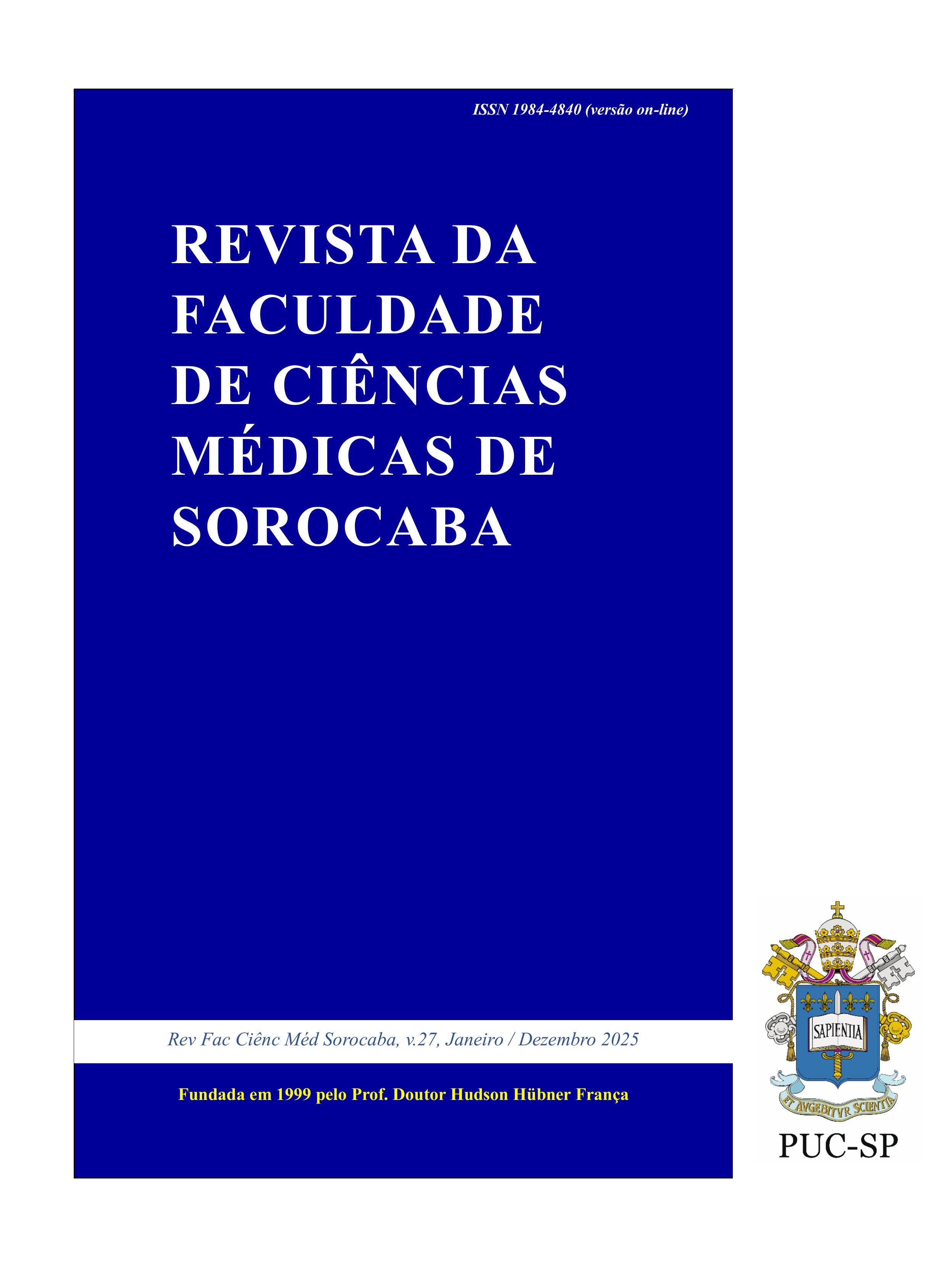Dados epidemiológicos de gestantes com COVID-19 em Sorocaba, São Paulo e Brasil
DOI:
https://doi.org/10.23925/1984-4840.2025v27a5Palavras-chave:
COVID-19/epidemiologia, Complicações Infecciosas na Gravidez, GravidezResumo
Objetivo: este artigo busca investigar os dados epidemiológicos da COVID-19 em gestantes nos níveis nacional, estadual e municipal. Metodologia: foram utilizados dados do Observatório Obstétrico Brasileiro (OOBr) entre março de 2020 e junho de 2022. A análise descritiva foi empregada para integração dos dados, complementada pelo teste de Tukey para Comparações Múltiplas de Proporções, conforme descrito por Zar, considerando significativos os valores de p inferiores a 0,05. Resultados: entre março de 2020 e junho de 2022, o Brasil registrou 22.245 casos e 2.031 óbitos por COVID-19 grave em gestantes, com o pico de mortalidade observado em 2021. Mulheres jovens, com idades entre 20 e 34 anos, ensino médio completo e predominantemente pardas foram as mais afetadas. Mulheres negras apresentaram maiores taxas de complicações e mortalidade, evidenciando o impacto do racismo estrutural, condições socioeconômicas desfavoráveis e acesso limitado a serviços de saúde. O terceiro trimestre gestacional destacou-se como o período de maior vulnerabilidade. Conclusão: análise revelou que grávidas jovens, pardas e negras foram as mais afetadas pela COVID-19, refletindo desigualdades sociais e raciais. O terceiro trimestre foi o período de maior risco, com piora em 2021 devido à baixa vacinação, mas melhora em 2022 com a imunização em massa. O estudo reforça a necessidade de políticas públicas para equidade no acesso à saúde e combate à desinformação.
Referências
Guan WJ, Ni ZY, Hu Y, Liang WH, Ou CQ, He JX, et al. Clinical characteristics of coronavirus disease 2019 in China. N Engl J Med. 2020;58(4):711–2. doi: 10.1056/NEJMoa2002032.
Lamers MM, Haagmans BL. SARS-CoV-2 pathogenesis. Nat Rev Microbiol. 2022;20(5):270–84. doi: 10.1038/ s41579-022-00713-0.
Overton EE, Goffman D, Friedman AM. The epidemiology of COVID-19 in pregnancy. Clin Obstet Gynecol. 2022;65(1):110–22. doi: 10.1097/GRF.0000000000000674.
Allen DW. COVID-19 lockdown cost/benefits: a critical assessment of the literature. Int J Econ Business 2022;29(1):1–32. doi: 10.1080/13571516.2021.1976051.
Secretaria da Saúde de São Paulo (BR). Vacinômetro, vacina já e vacivida [Internet]. 2022 [acesso em 10 jan. 2024]. Disponível em: https://vacinaja.sp.gov.br/vacinometro/
Torres-Torres J, Martinez-Portilla R, Spino-Y-Sosa S, Estrada-Gutierrez G, Solis-Paredes J, Villafan-Bernal JR et al. Comorbidity, poverty and social vulnerability as risk factors for mortality in pregnant women with confirmed SARS-CoV-2 infection: analysis of 13 062 positive pregnancies including 176 maternal deaths in Mexico. Ultrasound Obstet Gynecol. 2021;59:76–82. doi: 10.1002/uog.24797.
Qeadan F, Mensah NA, Tingey B, Stanford JB. The risk of clinical complications and death among pregnant women with COVID-19 in the Cerner COVID-19 cohort: a retrospective analysis. BMC Pregnancy Childbirth. 2021;21(1):305. doi: 10.1186/s12884-021-03772-y.
Narang K, Enninga EAL, Gunaratne MDSK, Madugodaralalage DSK, Gunaratne, MBBS, Eniola R et al. SARS-CoV-2 iInfection and COVID-19 during pregnancy: a multidisciplinary review. Mayo Clin Proc. 2020;95(8):1750–65. doi: 10.1016/j.mayocp.2020.05.011.
Serra FE, Francisco RPV, Rossi P, Brizot ML, Rodrigues AS. COVID-19 outcomes in hospitalized puerperal, pregnant, and neither pregnant nor puerperal women. Plos One. 2021;16(11): e0259911. doi: 10.1371/journal.pone.0259911.
Brasil. Ministério da Saúde. Manual de recomendações para a assistência à gestante e puérpera frente à pandemia de COVID-19. 2ª ed. Brasília (DF): Ministério da Saúde; 2021.
Observatório Obstétrico Brasileiro. OOBr SRAG: Síndrome respiratória aguda grave em gestantes e puérperas [Internet]. 2021 [acesso em 13 ago 2023]. Disponível em: https://observatorioobstetrico.shinyapps.io/covid_gesta_puerp_br
Zar JH. Biostatistical analysis. Vol. 5. New Jersey: Pearson; 2010.
Brito JGE, Alencar CCA, Lemos, AC, Caetano CLR, Menezes MO, Barreiro MSC. Características clínicas, sociodemográficas e desfechos de gestantes hospitalizadas com COVID-19. Res Soc Dev. 2021;10(17): e33101723049. doi: 10.33448/rsd-v10i17.23049.
Barbosa Filho MC, Lopes FNB, Viana JFS, Ferreira BO. Síndrome respiratória aguda grave por COVID-19: perfil epidemiológico em gestantes e puérperas no Amazonas. Medicina (Ribeirão Preto). 2022;55(2):1-10. doi: 10.11606/issn.2176-7262.rmrp.2022.194706.
Wheeler JM, Misra DP, Giurescu C. Stress and coping among pregnant black women during the COVID-19 pandemic. Public Health Nurs. 2021;38:596–602. doi: 10.1111/phn.12909.
Góes EF, Ferreira AJF, Ramos D. Racismo antinegro e morte materna por COVID-19: o que vimos na Pandemia? Ciênc Saúde Coletiva. 2023;28(9):2501–10. doi: 10.1590/1413-81232023289.08412022.
Santos FBD, Silva SLBD. Gênero, raça e classe no Brasil: os efeitos do racismo estrutural e institucional na vida da população negra durante a pandemia da COVID-19. Rev Direito Práx. 2022;13(3):1847–73. doi: 10.1590/2179-8966/2022/68967.
Naurin E, Markstedt E, Stolle D, Enström D, Wallin A, Andreasson I et al. Pregnant under the pressure of a pandemic: a large-scale longitudinal survey before and during the COVID-19 outbreak. Eur J Public Health. 2021;31(1):7–13. doi: 10.1093/eurpub/ckaa223.
Parra-Saavedra M, Villa-Villa I, Pérez-Olivo J, Guzman-Polania L, Galvis-Centurion P, Cumplido-Romero A et al. Attitudes and collateral psychological effects of COVID-19 in pregnant women in Colombia. Int Gynecol Obstet. 2020;203–8. doi: 10.1002%2Fijgo.13348.
Souza ASR, Amorim MMR. Maternal mortality by COVID-19 in Brazil. Rev Bras Saude Mater Infant. 2021;21(suppl 1):253–6. doi: 10.1590/1806-9304202100S100014.
Bergantini LS, Ichisato SMT, Salci MA, Birolim MM, Santos MLAD, Höring CF, et al. Fatores associados a hospitalizações e óbitos de gestantes paranaenses por COVID-19: estudo transversal. Rev Bras Epidemiol. 2024;27:e240005. doi: 10.1590/1980-549720240005.2.
Mohammed I, Nauman A, Paul P, Ganesan S, Chen KH, Jalil SMS, et al. The efficacy and effectiveness of the COVID-19 vaccines in reducing infection, severity, hospitalization, and mortality: a systematic review. Hum Vaccin Immunother. 2022;18(1):2027160. doi: 10.1080/21645515.2022.2027160.
Downloads
Publicado
Como Citar
Licença
Copyright (c) 2025 Revista da Faculdade de Ciências Médicas de Sorocaba

Este trabalho está licenciado sob uma licença Creative Commons Attribution-NonCommercial 4.0 International License.
Os autores no momento da submissão transferem os direitos autorais, assim, os manuscritos publicados passam a ser propriedade da revista.
O conteúdo do periódico está licenciado sob uma Licença Creative Commons 4.0, esta licença permite o livre acesso imediato ao trabalho e que qualquer usuário leia, baixe, copie, distribua, imprima, pesquise ou vincule aos textos completos dos artigos, rastreando-os para indexação, passá-los como dados para o software, ou usá-los para qualquer outra finalidade legal.

 Este obra está licenciada com uma Licença
Este obra está licenciada com uma Licença 